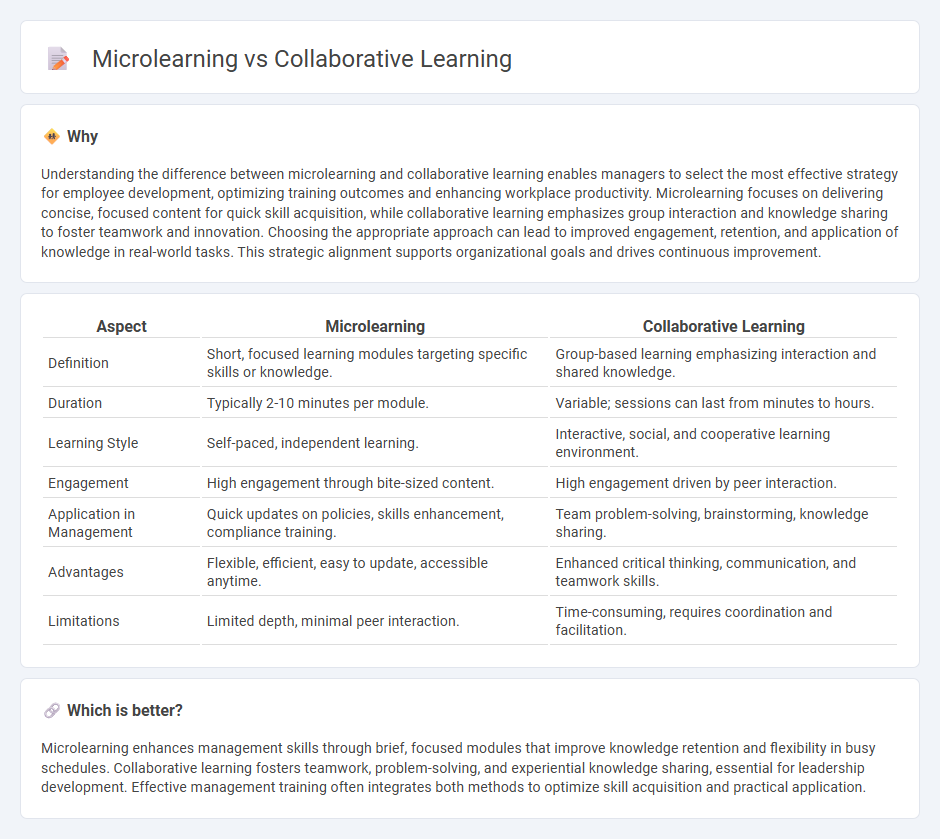
Microlearning delivers concise, focused content in short bursts, enhancing knowledge retention and flexibility for busy professionals. Collaborative learning fosters teamwork and critical thinking by encouraging interaction and shared problem-solving among peers. Discover how integrating both methods can optimize training effectiveness.
Why it is important
Understanding the difference between microlearning and collaborative learning enables managers to select the most effective strategy for employee development, optimizing training outcomes and enhancing workplace productivity. Microlearning focuses on delivering concise, focused content for quick skill acquisition, while collaborative learning emphasizes group interaction and knowledge sharing to foster teamwork and innovation. Choosing the appropriate approach can lead to improved engagement, retention, and application of knowledge in real-world tasks. This strategic alignment supports organizational goals and drives continuous improvement.
Comparison Table
| Aspect | Microlearning | Collaborative Learning |
|---|---|---|
| Definition | Short, focused learning modules targeting specific skills or knowledge. | Group-based learning emphasizing interaction and shared knowledge. |
| Duration | Typically 2-10 minutes per module. | Variable; sessions can last from minutes to hours. |
| Learning Style | Self-paced, independent learning. | Interactive, social, and cooperative learning environment. |
| Engagement | High engagement through bite-sized content. | High engagement driven by peer interaction. |
| Application in Management | Quick updates on policies, skills enhancement, compliance training. | Team problem-solving, brainstorming, knowledge sharing. |
| Advantages | Flexible, efficient, easy to update, accessible anytime. | Enhanced critical thinking, communication, and teamwork skills. |
| Limitations | Limited depth, minimal peer interaction. | Time-consuming, requires coordination and facilitation. |
Which is better?
Microlearning enhances management skills through brief, focused modules that improve knowledge retention and flexibility in busy schedules. Collaborative learning fosters teamwork, problem-solving, and experiential knowledge sharing, essential for leadership development. Effective management training often integrates both methods to optimize skill acquisition and practical application.
Connection
Microlearning enhances management training by delivering concise, targeted content that promotes immediate application, while collaborative learning fosters teamwork and knowledge sharing essential for effective leadership. Integrating microlearning with collaborative approaches accelerates skill development and improves problem-solving within management teams. This combination supports continuous learning ecosystems, enabling managers to adapt swiftly to dynamic business environments.
Key Terms
Teamwork vs. Bite-sized Content
Collaborative learning emphasizes teamwork by engaging participants in shared tasks and interactive communication, which enhances problem-solving skills and collective knowledge building. Microlearning delivers bite-sized content designed for quick consumption and repeated review, improving retention through focused, manageable learning units. Explore how combining both approaches can maximize educational outcomes and boost learner engagement.
Social Interaction vs. Self-paced Modules
Collaborative learning emphasizes social interaction by engaging learners in group discussions, peer feedback, and shared problem-solving activities that enhance communication skills and collective knowledge construction. Microlearning delivers self-paced modules designed for rapid knowledge acquisition through short, focused bursts of content, catering to individual learning preferences and busy schedules. Explore the advantages of both methods to determine the best fit for your educational needs.
Knowledge Sharing vs. Just-in-time Learning
Collaborative learning emphasizes knowledge sharing through group interactions, promoting deeper understanding and diverse perspectives by engaging multiple participants in problem-solving and discussion. Microlearning focuses on just-in-time learning by delivering concise, targeted content that addresses immediate skill gaps or knowledge needs, enhancing retention and application in fast-paced environments. Explore how integrating both methods can optimize learning strategies for varied educational goals.
Source and External Links
Cooperative and Collaborative Learning - This webpage describes collaborative learning as an instructional strategy where participants work in teams to explore significant questions or create meaningful projects.
Collaborative Learning - This resource explains collaborative learning as a type of learning where students work in pairs or small groups to discuss concepts or find solutions to problems, promoting higher-level thinking and social skills.
Collaborative Learning Approaches - This webpage discusses collaborative learning as an approach involving pupils working together in small groups on activities or tasks, highlighting its positive impact on attainment with proper support and task design.
 dowidth.com
dowidth.com